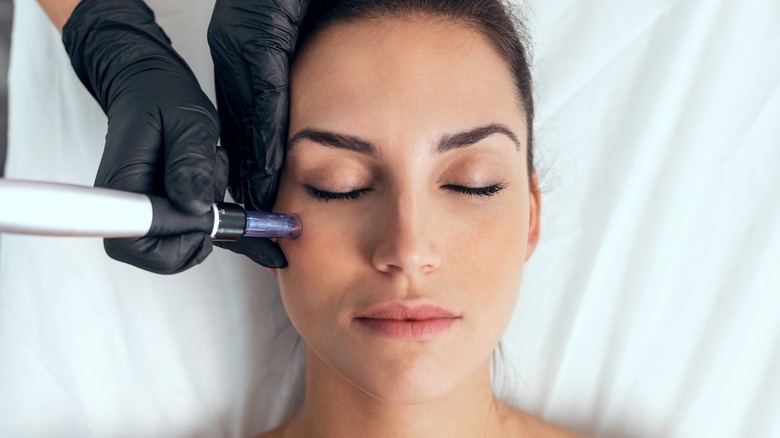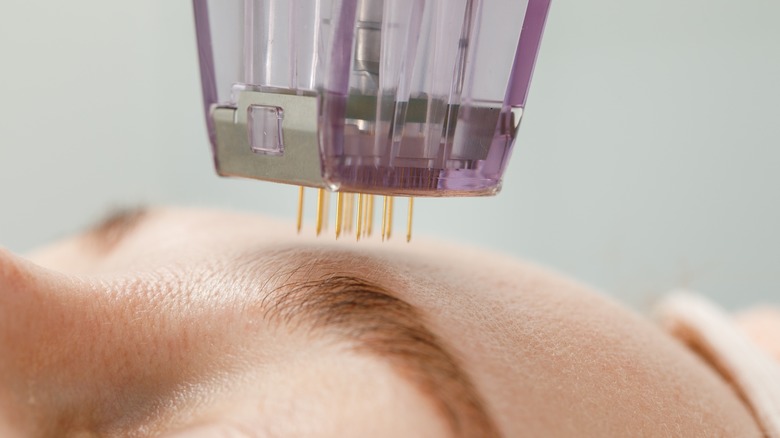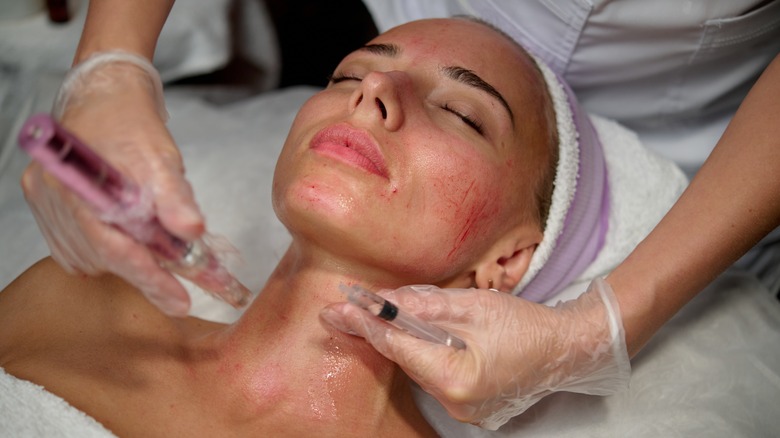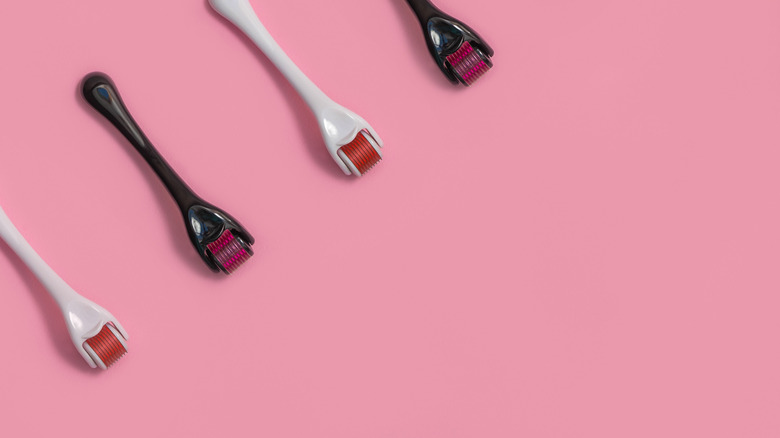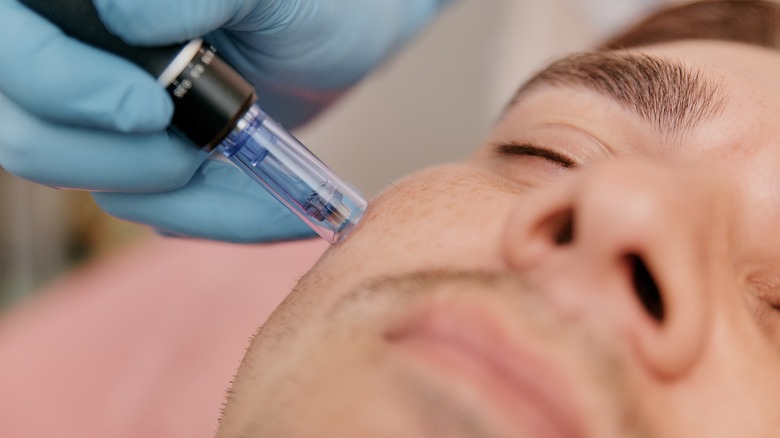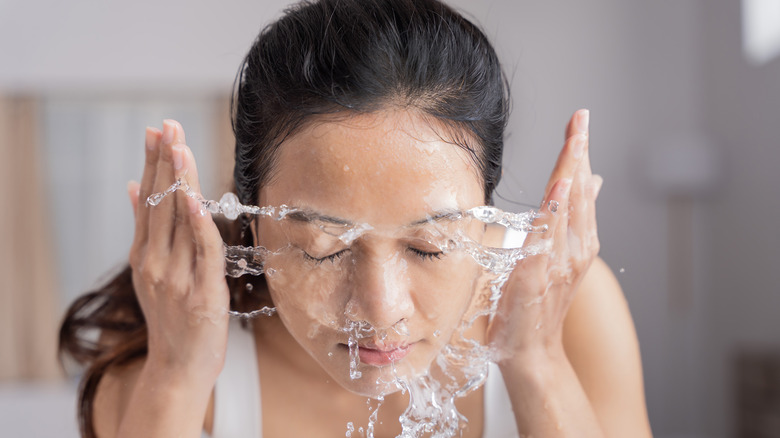What Are The Dangers Of Microneedling?
There's no denying that the number of yearly cosmetic procedures is rising — and so are safety concerns. Even non-invasive procedures can carry risks of complications and side effects. One cosmetic procedure raising concerns is microneedling — a procedure intended to stimulate the body's production of collagen and elastin by using fine needles to create tiny punctures in the skin, per the Cleveland Clinic. It is typically performed using a handheld roller or tool with attached needles. The needles come in different lengths, depending on the area to be treated and the desired results.
Microneedling can be performed on the face, neck, and back, but is most commonly used on the face to improve the appearance of fine lines, wrinkles, acne scarring, and other signs of aging. Before the procedure, a numbing cream is applied, says WebMD. The practitioner will then use the microneedling device to create tiny punctures in the skin. The procedure is usually not too painful, but some people may experience discomfort. As with any cosmetic procedure, there are some potential risks and side effects associated with microneedling.
Dangers and risks of microneedling
While microneedling is generally considered to be a safe procedure, two of the most common side effects of microneedling are redness and irritation of the skin. This is usually temporary and should resolve within a few days, according to Yale Medicine. Other possible side effects of the procedure include bleeding, bruising, or infection at the site of the needles, per Medical News Today.
Also, note that some people may not be good candidates for certain cosmetic procedures due to their health condition, medications they are taking, or other factors. Therefore, a thorough medical assessment and consultation are crucial before any cosmetic procedure. For example, people with active acne or open wounds or taking anticoagulants (blood thinning medications) must first consult with a medical professional, says the Cleveland Clinic. A skincare professional or licensed esthetician can help determine if microneedling is appropriate for your skin type and concerns.
Is microneedling FDA approved?
The Food and Drug Administration (FDA) classifies microneedling devices as class II medical devices, considered moderate to high risk. Microneedling devices should not be confused with dermabrasion devices classified as low-risk devices, which means that the FDA does not require premarket review or clearance (but the manufacturers are still responsible for ensuring their safety and effectiveness), as noted on the FDA site.
The FDA also emphasizes the importance of ensuring that the needles and the device used are sterile and that the procedure is performed in a clean and safe environment. Also, keep in mind that not all microneedling devices are created equal, and the effectiveness and safety of the devices can vary. Therefore, it is essential to check that the device is FDA-cleared and check the FDA's database of medical device recalls to ensure that the device being used has not been recalled for safety reasons.
What are the approved microneedling devices?
The FDA has cleared certain microneedling devices to treat certain medical conditions such as acne, scarring, and wrinkles. However, the FDA clearance applies only to the specific indications and patient population for which the device was tested. For example, a device that is cleared for treating acne may not be suitable for treating other skin concerns like fine lines and wrinkles.
One FDA-cleared device is the SkinPen Precision, which is approved for treating acne scars and fine lines on the face. The Rejuvapen is FDA-cleared for treating fine lines and wrinkles, acne scars, and age spots. Lastly, the Eclipse Micropen EVO is FDA-cleared for treating fine lines and wrinkles, acne scars, and age spots.
Although approved, not all microneedling devices are FDA-cleared, and some of them may not be safe or effective for everyone. Therefore, it's best to opt for those recommended by a dermatologist.
Precautions to take before microneedling
Before undergoing microneedling, you'll have to take certain precautions to ensure that the treatment is safe and effective. Firstly, consult with a skincare professional or licensed esthetician to determine if microneedling is appropriate for your skin type and concerns. You might also be advised to avoid sun exposure and tanning before and after the treatment. This is especialy important in the first week after the treatment, as the procedure can make you more prone to sun damage, says Healthline. If you must go out in the sun, wear sunscreen.
Last, in order to minimize the risk of infection, be sure to clean your skin thoroughly on the day of the treatment using a pH-balanced cleanser advises Healthline. According to the source, if the treatment involves the use of a derma roller with needles beyond 0.5 mm, it's vital to wipe the skin down with 70% isopropyl alcohol prior to treatment.
Precautions to take after microneedling
Healthline also advises against using exfoliating products that can increase skin sensitivity, such as retinoids, vitamin C, or alpha hydroxy acids, for 48 hours after treatment. These products can cause the skin to become more sensitive and increase the risk of complications. It's also important to ensure that the needles and the device used are sterile — the needles should be properly cleaned and disinfected between each treatment.
Try to follow post-treatment instructions carefully. Your practitioner might provide specific instructions on how to care for your skin after the treatment, including how to clean the treated area, what products to use, and when to avoid sun exposure. These instructions are crucial for ensuring the best results and minimizing the risk of complications.
In conclusion, microneedling is a safe and effective treatment for many skin concerns. By taking these precautions and working with a qualified practitioner, you can ensure that you achieve the best results and minimize the risk of complications.
